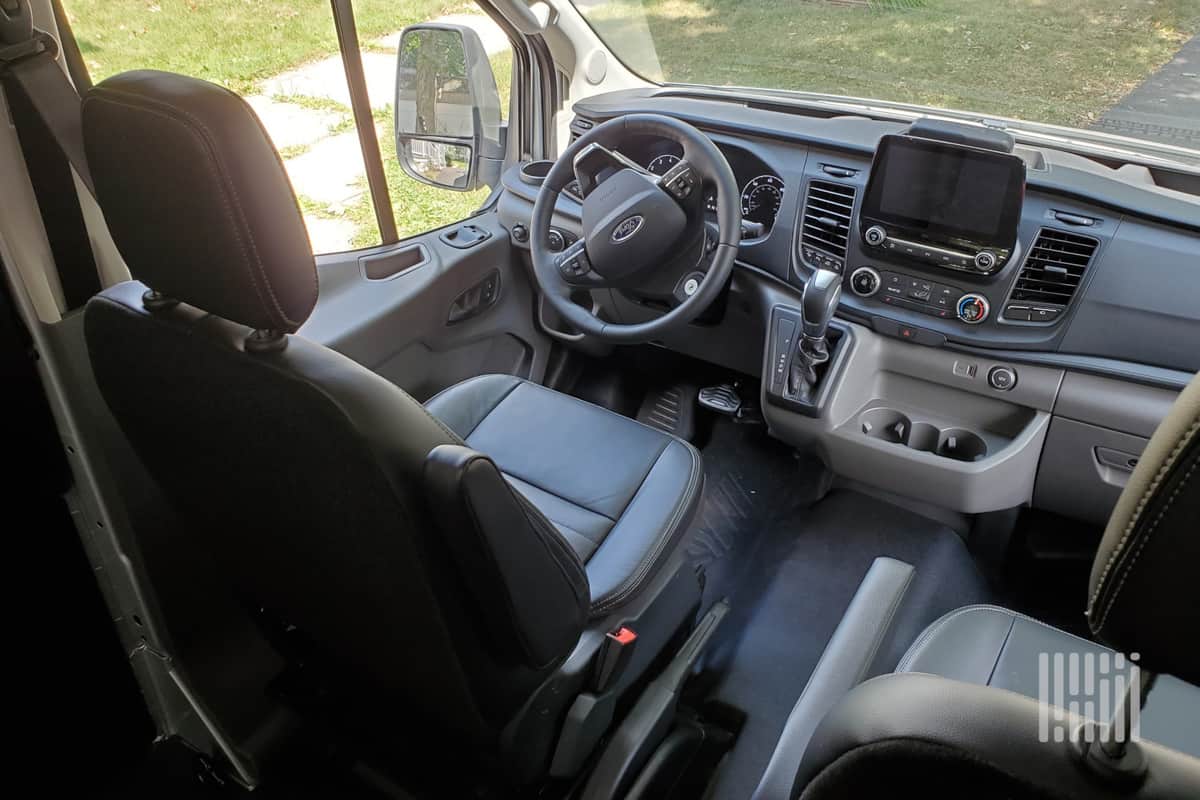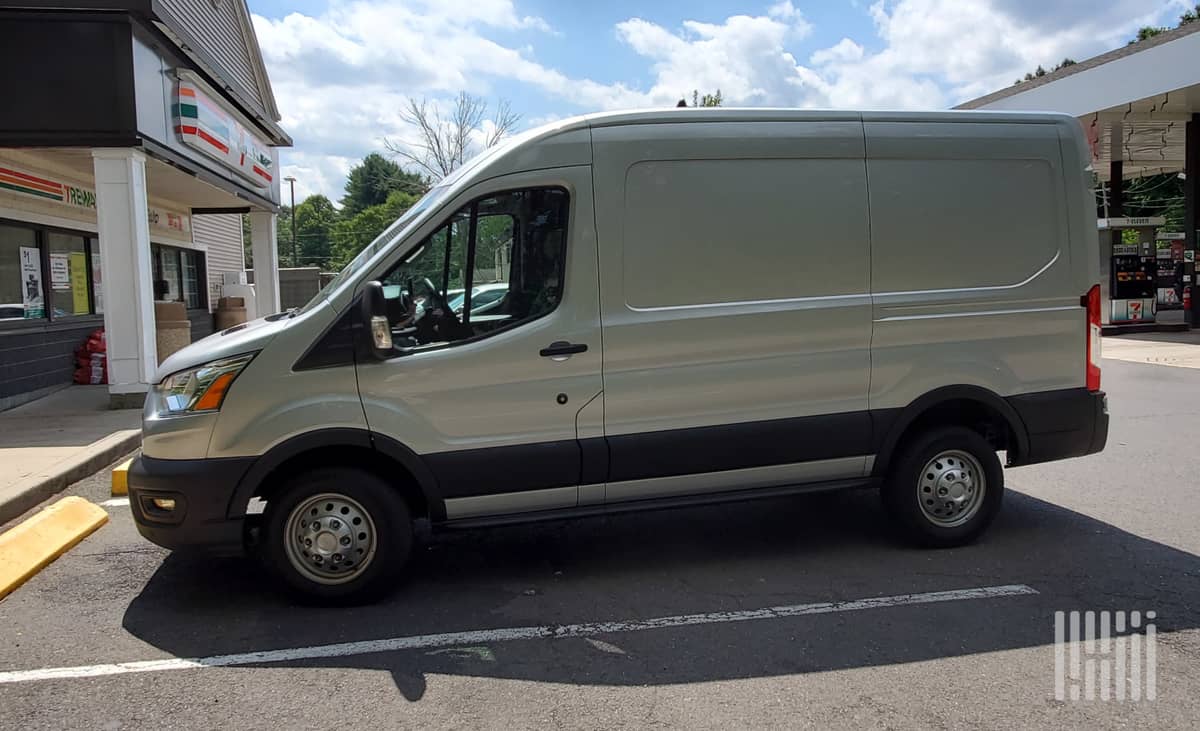As e-commerce has boomed, so too have the number of last-mile providers to get those packages delivered to doorsteps around the country. For many, that has meant a decision on a vehicle that can handle the job.
All the major automotive manufacturers offer van options, and there are plenty of step-van manufacturers as well hoping to fill the need. Through it all, the Ford Transit has remained the best-selling cargo van in the U.S. and Canada, extending a 41-year reign atop the commercial van wars for the automaker.
The Transit may be ideal for service trades such as electricians, plumbers and florists, but it is increasingly a popular choice for last-mile package delivery firms.

FreightWaves recently had the chance to test drive a 2020 Transit. And while there were no packages delivered in this test drive, it was easy to see why Ford’s (NYSE: F) van is a popular choice for commercial vehicle owners. We were dismayed, though, to see an excessive idling event took place on our watch. Were we really parked that long? Ford Telematics said we were. We’ll have more on that later.
But first, let’s get into the vehicle and its performance. The model we tested was a 2020 Transit 150 medium-roof cargo van with all-wheel drive. (Ford also offers regular-roof and high-roof models; 150, 250 and 350 variations; and passenger, cargo, crew and chassis cab configurations.) The ingot silver metallic van featured a 130-inch wheelbase, Ford’s 3.5 liter PFDI (port fuel direct injection) gas engine (an EcoBoost V6 is optional) and a 10-speed transmission.
The van offered a spacious 224.5 cubic feet of cargo space.
With a base price of $40,355 (an entry-level model starts at $34,510), this van included plenty of standard features for delivery such as rear cargo doors with 180-degree swing-out, cargo tie-down hooks, A-pillar and B-pillar assist handles, and ample storage in the center console and over the dash. Interior LED lighting and plenty of safety features come standard, including forward collision warning, lane-keeping assist, adaptive cruise control, post-collision braking, rear-view camera with trailer hitch assist and side-wind stabilization. Also standard is a FordPass Connect 4G WiFi hotspot telematics modem, which powers the optional Ford Telematics platform and can connect up to 10 devices to the internet, a key benefit to help last-mile operators stay connected without ringing up expensive data charges.
The vehicle we drove included optional equipment such as front/rear split-view camera, Blind Spot Information System (BLIS) with cross-traffic alert and enhanced park assist that added $6,745 to the price of the vehicle.

Comfortable ride
Ray Eyles, chief program manager for Ford Transit North America, told us the van offers “the most car-like drive of all the vans,” and he was right. Visibility through the large front window and equally spacious door windows offered a 180-degree view of the roadway and the vehicle’s immediate surroundings. Combined with the backup camera and side-alert notifications of objects in the van’s blind spots, it left us confident we were never exposed to unnecessary risk.
Unlike the vans of yesteryear, the 2020 Transit offered a smooth ride — not quite on par with high-end cars but far superior to the ride many are used to in a traditional van or truck. It is a much appreciated and often overlooked aspect for a package delivery driver who is spending eight to 10 hours in the van on a daily basis.
Another nice safety-focused aspect was the short-arm door mirrors. Packed neatly next to the vehicle, they provided plenty of visibility without extruding more than a foot from the van. This kept it compact but also made it easy for the driver’s eyes to check the mirrors without excessive neck strain turning the head.

Interior/exterior built for last mile
The Transit is truly a multipurpose van.
“Transit is very close to hitting the bull’s-eye with a lot of our customers, but there [were a few things they still wanted],” Eyles mentioned. A customer advisory board helped Ford make some mid-cycle model year tweaks that included additional safety features such as automatic emergency braking with pre-collision assistance.
Lane-keeping assist became standard, and as we experienced, will gently nudge the vehicle back into line. Our biggest complaint was that the nudging could be a little stiffer – it seemed very easy to steer through the warning.
Inside, the 8-inch dash (a 4-inch multifunction display is standard) was simple yet feature rich. Toggling through options provided various details on the vehicle, including miles per gallon, trip miles, rpm, fuel, engine temperature, digital speed odometer and miles to empty. If you preferred, any one option could be displayed for simplicity. Speed is also displayed continuously in a traditional gauge format.
An 8-inch touchscreen display handled all the communication needs, including navigation. It includes Ford’s Sync 3 with Android Auto and Apply Carplay capabilities, Bluetooth and satellite radio. Automotive-style navigation is included on the steering wheel. Importantly, for last-mile drivers, the system automatically lowered the volume of the radio when navigation directions were announced.
The standard seat provided a little more difficult transition to the cargo hold of the vehicle, although Eyles noted that additional ergonomic changes in this area are coming in the 2021 model year. If you are purchasing the vehicle for last-mile deliveries, we would suggest splurging for the optional swivel seats. Heated seats are also an option and well worth the cost for drivers in and out of vehicles in colder climates.
Getting into and out of the vehicle was very easy, though, thanks to the step inside the front door and the A-pillar grab handles added for the 2020 model year. There is an additional fold-down step option.
Fuel economy
Ford did not provide fuel economy data for the vehicle, but according to fueleconomy.gov, the Transit 150 should obtain 17 miles per gallon (mpg) combined city/highway. We were a little shy of that, but we also had several idling events that pulled down the mpg. On straight roads, the fuel economy estimate appeared accurate by our accounts. Auto start/stop is included with the EcoBoost engine and will further limit unnecessary fuel usage.
Those looking for something even more efficient will have to wait until the 2022 model year, when Ford is expected to introduce an all-electric Transit.

Ford Telematics package
Our test vehicle came equipped with the optional Ford Telematics and the associated Ford Drive app – a must-have for any fleet operator. The system provides real-time data on the vehicle, and with the accompanying driver app, makes pre-trip inspections a breeze.
Initially, we were dismayed to learn that our every movement would be tracked, but after the shock wore off, we did find ourselves focused on driving safely and efficiently – with the exception of the previously mentioned idling event that lasted 10 minutes, 30 seconds. After the first day, we basically forgot about the tracking portion of the system and focused only on the driving.
Ford Telematics allows customers to monitor their fleets through GPS tracking and geofencing, but it also provides live vehicle health alerts with proactive notifications, reminders for vehicle service, fuel usage trends and driver behavior insights.
Managers reviewing telematics reports for their fleets would see the number and type of vehicles, vehicle health status including how many require immediate action, current geofencing status, vehicle utilization, connectivity issues and driver behavior.
The dashboard also allows managers to search for all vehicles on a map or just specific vehicles, including those vehicles with certain characteristics such as booms, Travis Hunt, business development manager for Ford, explained.
Along with Ford Telematics, which uses factory-installed modems that are standard on all 2020 Ford vehicles, the Transit comes with the Ford Telematics Drive mobile app. The app, available through the Apple App Store and Google Play, is a great way for noncommercial drivers to ensure the vehicle they are stepping into is safe and functioning properly. To get started, a driver simply inputs or scans the vehicle’s VIN number to be assigned to the vehicle.
In the test drive, we were able to easily perform a pre-check of the vehicle’s important systems through the vehicle health report. The app guided me through the checklist (lights, oil levels, tire health, etc.) and allowed the opportunity to add additional areas of concerns, which can be sent back to a fleet manager.
The Drive app connects the driver to the specific vehicle to ensure that reporting is assigned to that driver.
Hunt said additional functionality is being developed for Ford Telematics, which was only launched in June.
Fleet managers can easily see how efficient each driver is based on miles driven, fuel consumed and a fuel-efficiency calculation of the vehicle. Ford Telematics also identifies how much fuel was used due to idling.
Driver behavior attributes are still being built into the system. Currently, only seat belt usage is tracked. Also, Hunt noted that using Ford’s modem, a customer can connect another company’s telematics package without the need to install additional hardware.
“We think very highly of Ford Telematics and we hope to sell a lot of the service, but if it doesn’t meet your needs, you can [subscribe to others],” he said.
Ford Telematics is $20 per vehicle per month. Based only on our single-day report, a fleet could easily recoup that $20 price tag in reduced fuel usage and improved driver coaching that could reduce risk and potentially insurance premiums.

Recommendation
There is a lot to like about Ford’s Transit van. And you don’t have to take our word for it. A look at sales figures tells the story. In Q4 of 2019, Ford delivered 36,885 units – an 18% year-over-year increase. For all of 2019, Transit sales increased 12% to 153,868 units.
Overall, the Transit provides a smooth ride, comfortable seating and plenty of safety and telematics functionality to make it an excellent choice for last-mile operations. Could there be improvements? Sure. Eyles said some of our concerns would be addressed in the 2021 model as the OEM continues to collect feedback from customers and modify the vehicle as it goes.
The majority of last-mile drivers are not commercial drivers by trade, so Ford’s approach to building an easy-to-drive, car-like van option eases the transition into a professional driving career for most.
There are plenty of options available for commercial vans, and each fleet will have its own requirements, but there aren’t many options that provide the all-around value the Ford Transit does.
Click for more FreightWaves articles by Brian Straight.
You may also like:
Here’s where electric trucks make sense
Technology is changing the way freight brokerages operate
Trucking companies caught in Trump’s payroll tax deferment order











Smart Contract MLM Software
Thanks for sharing your knowledge!